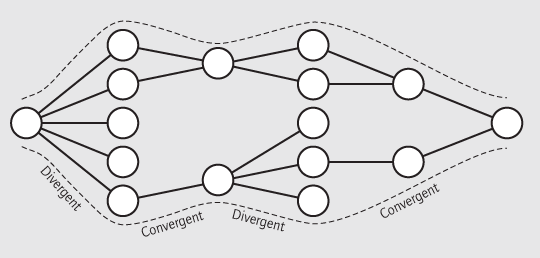For some people, being creative is being able to paint, draw, sing, or play an instrument. So when they are not good at any of these creative activities, they don’t consider themselves creative. They might enjoy the aesthetic of it, but they can’t produce it.
This conception of creativity is too narrow. There is more to it than a piece of art. Think about what you create, change, improve, initiate in your job and in your life. These are other aspects of creativity. You will find below the main research made about creativity in the last 50 years, so you can name what type of creative person you are.
Convergent vs. divergent thinking
The American psychologist J. P. Guilford was one of the first to work on intelligence assessment and creativity. He coined the terms “divergent” and “convergent” thinking in the late 50s.
Guilford described convergent thinking is the act of gathering facts and data to give one simple answer, possibly the correct one, to a problem. It doesn’t leave any room to flexibility or ambiguity. It is the type of thinking used to answer multiple-choice questionnaires.
Divergent thinking is the opposite of convergent thinking. It’s the process of generating multiple ideas from one topic, of exploring as many solutions as possible to a problem. There is no right or wrong answer in divergent thinking. It is the type of thinking used in brainstorming sessions, where participants share a flow of ideas associated with the topic, before using convergent thinking to narrow the solutions down.
Divergent thinking is a creative thinking because it lets people think outside the box by making connection between things that would not necessarily be connected in a more restricted environment.
The visual below shows what divergent and convergent thinking look like:

Hierarchy of ideas
Another great concept to look at when discussing creativity is the hierarchy of ideas. This is a model used in coaching to support clients in exploring a topic in different ways, looking at the big picture or the details, while doing lateral thinking.

If you are a divergent thinker and are brainstorming specific solutions to a single problem, your thought process will be on the lower left-hand side of the graph. When you do convergent thinking, you go from the top to the bottom of this same graph.
You can basically place any of your ideas of this map to see where they currently are, and where else they could go to see the topic under a different light.
Multiple intelligences
We already talked about multiple intelligences on the blog, but I thought it was important to mention it again in an article on creativity. We all have natural preferences, and we express creativity differently based on who we are and our environment. Take a look at the 8 intelligences developed by Howard Gardner:
- Visual – Spatial
- Bodily – Kinesthetic
- Musical
- Interpersonal
- Intrapersonal
- Linguistic
- Logical – Mathematical
- Naturalistic
A person with more musical preferences than others would naturally be more creative in that field. Someone who is more logical – mathematical will have a more creative approach to numbers, systems and processes than someone who is more on the linguistic side. It all depends on your fluency, your curiosity, your tolerance and your motivation to produce, share and implement something new or different.
So, are you creative?
Looking at creativity that way, you can see how there isn’t just one kind of creativity. Every time you think about a problem to solve, you imagine something, you day-dream, you plan something, you are being creative. Every time you start something or you change something, you are also being creative.
Now that you have that awareness, what is it that you can do to create something today?

